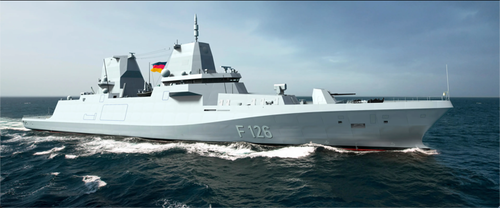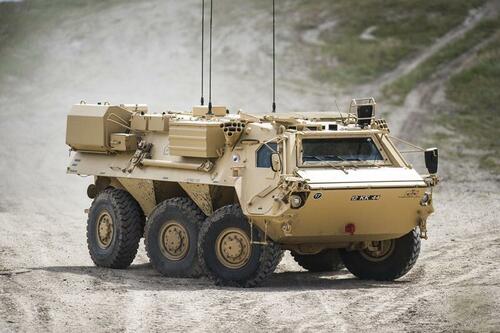
In 2006, NATO defense ministers agreed that each member country would commit at least 2% of its GDP to defense spending. Nearly two decades later, some member countries have not met the target, only to be recently reminded by former President Trump to ramp up defense spending or face severe consequences.
Perhaps Germany's ruling coalition heard Trump's warning loud and clear. A new Bloomberg report, citing people familiar with the plans, reveals the German government is planning to purchase two additional F126 frigates via Damen Group/Blohm plus Voss/Lürssen/German Naval Yards for three billion euros and 900 Fuchs armored vehicles manufactured by Rheinmetall for four billion euros.
F126
Fuchs armored vehicles
Bloomberg confirmed the 7 billion euros in spending for the two ships and 900 armored vehicles will "enable it to meet NATO's goal of spending at least 2% of gross domestic product annually on the military this year for the first time since it was agreed by the alliance's defense ministers in 2006."
German Chancellor Olaf Scholz reaffirmed Berlin's commitment to spend 2% of GDP on defense in mid-February.
"We Europeans must take much more care of our own security, now and in the future," Scholz said. It comes as NATO members across Europe were recently spooked when Trump suggested he would not defend "delinquent" NATO allies.
One has to wonder if Germany's move to meet the 2% threshold is because Trump's election odds in November look very promising over President Biden's.
According to the International Institute for Strategic Studies, European defense spending currently averages 1.6% of GDP. This means more military spending is inevitable for the bloc, which will only lead to a new decade of military spending as the defense bull market roars.
Shares of Leopard 2 tank-maker Rheinmetall in Germany continue to hit record highs.
David Asher, a senior fellow at the Hudson Institute, recently pointed out opportunities in the European defense sector:
"Rheinmetall is screaming hot, but there are many other European arms manufacturers who stand to benefit. No doubt that for the NATO members dramatically increasing defense spending is their best defense against Putin's threats of offense. Same with a potential Trump return as President and demands that they either dramatically pick up defense spending and burden sharing or be shunted aside at an incredibly dangerous time."
A dangerous emerging multipolar world only bodes well for the bull market in the defense sector.
In 2006, NATO defense ministers agreed that each member country would commit at least 2% of its GDP to defense spending. Nearly two decades later, some member countries have not met the target, only to be recently reminded by former President Trump to ramp up defense spending or face severe consequences.
Perhaps Germany’s ruling coalition heard Trump’s warning loud and clear. A new Bloomberg report, citing people familiar with the plans, reveals the German government is planning to purchase two additional F126 frigates via Damen Group/Blohm plus Voss/Lürssen/German Naval Yards for three billion euros and 900 Fuchs armored vehicles manufactured by Rheinmetall for four billion euros.
F126
Fuchs armored vehicles
Bloomberg confirmed the 7 billion euros in spending for the two ships and 900 armored vehicles will “enable it to meet NATO’s goal of spending at least 2% of gross domestic product annually on the military this year for the first time since it was agreed by the alliance’s defense ministers in 2006.”
German Chancellor Olaf Scholz reaffirmed Berlin’s commitment to spend 2% of GDP on defense in mid-February.
“We Europeans must take much more care of our own security, now and in the future,” Scholz said. It comes as NATO members across Europe were recently spooked when Trump suggested he would not defend “delinquent” NATO allies.
One has to wonder if Germany’s move to meet the 2% threshold is because Trump’s election odds in November look very promising over President Biden’s.
According to the International Institute for Strategic Studies, European defense spending currently averages 1.6% of GDP. This means more military spending is inevitable for the bloc, which will only lead to a new decade of military spending as the defense bull market roars.
Shares of Leopard 2 tank-maker Rheinmetall in Germany continue to hit record highs.
David Asher, a senior fellow at the Hudson Institute, recently pointed out opportunities in the European defense sector:
“Rheinmetall is screaming hot, but there are many other European arms manufacturers who stand to benefit. No doubt that for the NATO members dramatically increasing defense spending is their best defense against Putin’s threats of offense. Same with a potential Trump return as President and demands that they either dramatically pick up defense spending and burden sharing or be shunted aside at an incredibly dangerous time.”
A dangerous emerging multipolar world only bodes well for the bull market in the defense sector.
Loading…








